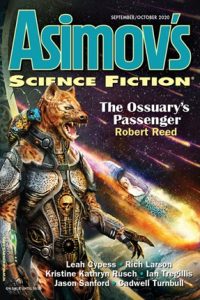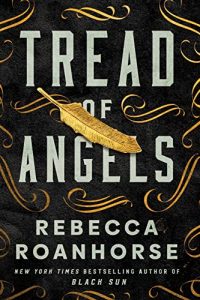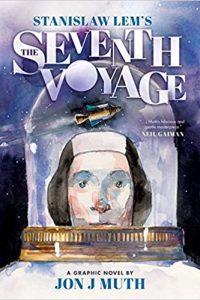Paul Di Filippo reviews Ben Bova
Ben Bova has forgotten more about science fiction than most of us will ever learn—and yet he still knows a hellacious amount, at the venerable and bountifully creative age of eighty-two. Since his first publication—The Star Conquerors, a YA SF novel in 1959, long before that kind of accomplishment became a trendy career move—he’s had 130 further books appear, and also edited Analog in the hard-shoes-to-fill interval after John Campbell’s death, as well as the fiction department of hot and trendy Omni afterwards. When you add to his CV his presidency of SFWA and his work in the aerospace industry, he emerges as a true Renaissance figure, central to the genre’s history. Probably not of the magnitude of a Fred Pohl, but certainly built along the same lines.
Of course, storytelling has always been his first claim to fame, and the fourteen tales in this new volume uphold his reputation splendidly. John Clute characterizes Bova’s niche as an old-school, straightforward, earnest booster of the quintessential ad astra pioneer philosophy at the genre’s roots and heart. But while many of the stories here hew to that outlook, the variety of others indicates a wider scope of ambition.
One note. Breaking its drought of short-story collections, Tor has done its usual fine job of crafting this volume, which features a beautiful cover by John Harris, except for their inexplicable decision to omit the copyright notices for the first publications of these pieces. Not a good or acceptable practice. Luckily for us, an Amazon reviewer named Arthur W. Jordin has kindly sourced the stories and posted the info, which I reproduce here, after verifying. Tor owes him a small stipend for doing some of their editorial work.
Sam Gunn is Bova’s Mike Fink-style folkloric demiurge, a typically American larger-than-life character, and all the stories in his cycle are tall tales told in jolly fashion. “Sam Below Par” (Analog, 2012) is no exception, as it features the building of the Moon’s first open-to-the-vacuum golf course. Recounted not by Gunn himself but by a Watson-type figure, the story features some romantic entanglements but, refreshingly, neither villainy nor violence.
The slower-than-light starship Sagan, heading toward Gliese 581 in “A Country for Old Men” (Going Interstellar, 2012), includes a dangerously bossy AI, lots of young adventurers and a single 140-year-old man, Dr. Ignatiev, our hero. Melancholy and isolated, Ignatiev eventually becomes the only one who can wrest the mission from the blindly self-destructive AI, coming to new self-realizations along the way.
Bova’s wonted plain style of prose adopts a sly and sarcastic edge in “In Trust” (Tombs, 1995). A billionaire dying of cancer thinks he’s found the perfect way to protect his wealth during his cryonic layover. He succeeds better than he planned, but with a certain “biter bitten” result.
Reminding me of a story Asimov would have written in a past era, or Nancy Kress would write today, “The Question” (Analog, 1998) deals with big philosophical issues revolving around a First Contact event. The shifts in POV from person to person lend it a neat structural experimentalism as well.
“‘We’ll Always Have Paris'” (original to this volume) is a short sequel to the famous film Casablanca, nothing more nor less. What distinguishes this little gem from mere fan fiction is ingenuity, the level of professionalism and a fidelity to the original.
As in “…Old Men,” the central dramaturgical configuration in “Waterbot” (Analog, 2008) is a human pilot and a ship’s AI. But the tone of the story and the relationship between the pair could not be more different, as our water prospector out in the Asteroid Belt finds himself in an intricate dance of survival against pirates with only his silicon partner to rely on.
Like some kind of future reality show, the vehicular competition in “Moon Race” (Jim Baen’s Universe, 2008) features memorable competitiors and some lateral thinking that is first punished, then rewarded. Hal Clement comes to mind as someone who might have turned out a similar piece, were he still with us.
A parable of twentieth-century events, “Scheherazade and the Storytellers” (Gateways, 2010) nonetheless remains lively and entertaining on its surface level, as we discover exactly where Scheherazade derived all her fabulistic prowess.
“Duel in the Somme” (Apex, 2006) forms a duet with “Bloodless Victory” (the title story of ebook Bloodless Victory, 2011). Both deal with the early forays into virtual reality, mainly for use as a “duelling machine,” and while neither possess the sophistication of, say, Ready Player One, they both have fun within their narrow boundaries.
Three scientists stranded on Mars heroically manage to continue their work into the mystery of the native methanogens in “Mars Farts” (Baenbooks.com, 2013). Their mortal dilemma proves to dovetail with their intellectual quest.
Employing a classic O’Henry-via-Heinlein ending, “A Pale Blue Dot” (Digital Book Production, 2013) finds a young lad loose in an astronomical observatory, where a wrong move could produce disaster.
“Inspiration” (F&SF, 1994) finds a time-traveler arranging a pivotal meeting among H. G. Wells, Lord Kelvin, and young Einstein, before his plans for the future run up against human biases.
Playing in the universe of Gordon Dickson’s “Call Him Lord”, “The Last Decision” (Stellar #4, 1984) is my favorite story of the volume, and a smart selection for the capstone. The Emperor of the Hundred Worlds finds himself in his waning days forced to make a Solomonic decision whose precise outlines elude him. Bova’s nuanced autumnal mood showcases some outstanding writing and pacing.
I once had a discussion with critic John Clute about Harry Harrison’s career-topping collection, 50 in 50. I was trying to puzzle out why the tales seemed almost alien now in their lineaments. Not fusty or wrong-headed or dull, for they still lived and gripped, but just anachronistic. Clute said, “The world is not narrated this way anymore.”
Ben Bova’s tales feel a bit like this. But he disproves Clute’s assertion, being an active, practicing writer who still manages to garb the mysteries and glories and tragedies of creation in clothes first tailored by all the SF geniuses who preceded him.








